Also IRCC, there is a recent peer-reviewed paper on the localisation of bass which showed that freq range might need an update to lower ranges than currently established... I just can't find it anymore.
I think I know what you mean, there was a recent conference in Australia, right ? I've seen that paper too.
It was discussed in diyaudio as well, and some had hard time to believe the results
That's exactly the problem, you just can't do that within an acoustically small room. You can do it with headphones but why the heck are low frequencies still not externalized? Something is wrong in Griesinger's theory.
To me it looks like only thing wrong is your interpretation on it ?
Scott,
Tell us again please why we should listen to that youtube clip ?
Because while listening to it I found out the deepest truth about youtube, the true meaning of it ! It sounds like coming from a tube, literally !
Are you telling you don't get in the head sound if you place a single mono bass speaker 0.5 m behind your head symmetrical to median plane at ear level located in the middle of the room ?
- Elias
That's the way the recording was recorded and intended to sound - as if in a large "tunnel-like" club. (..reminiscent of New Orleans Jazz clubs.)
I've never done that at ear level.. why would you?
*I'm not sure about the distance, could have been closer to a meter than half a meter.
A setup like you are describing sounds absurd.
I've never done that at ear level.. why would you?Under *all the other constraints though and adding proper phase rotation - yes. And the result was not "in the head".
*I'm not sure about the distance, could have been closer to a meter than half a meter.
A setup like you are describing sounds absurd.
Maybe it is absurd but according to Markus that should be the reference
Put a sub directly behind your listening position at shoulder height and get a frame of reference what good low frequency reproduction sounds like.
Ok, he says "shoulder height", not ear, but if one has really short neck it should be about the same
Maybe it is absurd but according to Markus that should be the reference
Ok, he says "shoulder height", not ear, but if one has really short neck it should be about the same
Yeah.. that doesn't sound right either.
When I've done a monaural sub like that it's been:
1. (sealed, ported, T-line, and dipole).
2. about a foot away from the listening chair.
3. ON THE FLOOR (and as a result more than a foot away from my head).
4. always required proper adjustment of crossover freq. and full variable phase rotation.
It hasn't always been in the center of the room either, though often closer to center than not and always with at least 4 feet away from any wall.
I'm not even saying that is particularly domestically acceptable.
I should also note that I have done stereo sub setups as "side tables" that were closer to my head.
Last edited:
Hello again,
Seems like we have drifted from the subject line
I was hoping to have some graphs of in-room impulse response from John using Elias's methods and look for reproducibility of the graphs obtained by Elias earlier, that clearly showed superior in-room transient response of dipole compared to sealed.
Or has everybody come to the unstated conclusion that if equalised to the same low end extension, there is no difference in sound quality between a sealed/cardioid/dipole woofer.
On my part, after some more carefully equalised responses of dipole and sealed, feel that they do come quite close. However, even then when crossed as low as 120Hz, I find that dipole woofers blend so seamlessly with dipole mains like magnepan. OTOH a sealed woofer has that slight overhanging sound, carrying them so far away from realism.
Seems like we have drifted from the subject line
I was hoping to have some graphs of in-room impulse response from John using Elias's methods and look for reproducibility of the graphs obtained by Elias earlier, that clearly showed superior in-room transient response of dipole compared to sealed.
Or has everybody come to the unstated conclusion that if equalised to the same low end extension, there is no difference in sound quality between a sealed/cardioid/dipole woofer.
On my part, after some more carefully equalised responses of dipole and sealed, feel that they do come quite close. However, even then when crossed as low as 120Hz, I find that dipole woofers blend so seamlessly with dipole mains like magnepan. OTOH a sealed woofer has that slight overhanging sound, carrying them so far away from realism.
The problem with this thread is the constant retreat to "Well it sounds good to me!" Its simply pointless to have a reasonable discussion when that is done because any side can do it and claim anything that they want (and often do). Unless we are talking about scientifically established facts its just a bunch of unsubstantiated opinions.
There is no established fact that two equal frequency responses will not sound the same. Scientifically I will continue to assume that they do because to assume anything else would be illogical.
There is no established fact that two equal frequency responses will not sound the same. Scientifically I will continue to assume that they do because to assume anything else would be illogical.
Two identical frequency responses need not sound the same do to temporal characteristics: Exponential swept sine and pink noise have same spectrum over time, and sound totally different. But yes, two equal frequency responses with similar phase properties sound highly similar.
Hello again,
Seems like we have drifted from the subject line
I was hoping to have some graphs of in-room impulse response from John using Elias's methods and look for reproducibility of the graphs obtained by Elias earlier, that clearly showed superior in-room transient response of dipole compared to sealed.
Or has everybody come to the unstated conclusion that if equalised to the same low end extension, there is no difference in sound quality between a sealed/cardioid/dipole woofer.
On my part, after some more carefully equalised responses of dipole and sealed, feel that they do come quite close. However, even then when crossed as low as 120Hz, I find that dipole woofers blend so seamlessly with dipole mains like magnepan. OTOH a sealed woofer has that slight overhanging sound, carrying them so far away from realism.
It's tough to draw any significant distinction between the radiation profile and the net result to the listener.
Each system: sealed/cardiod/dipole - is not identical irrespective of its radiation. (..JohnK's trick "flip a switch" sub setup would get pretty close though.)
Ex. the "slight overhang.." you hear may have something to do with its in-box operation (vs. that of "open baffle"), rather than it's interaction with the room.
Last edited:
Results for different near field configurations are in:
Comparison of different near field subwoofer configurations
I also did look at monopole/dipole in the far field. The dipoles were placed right next to the mains.
Dual monopole:
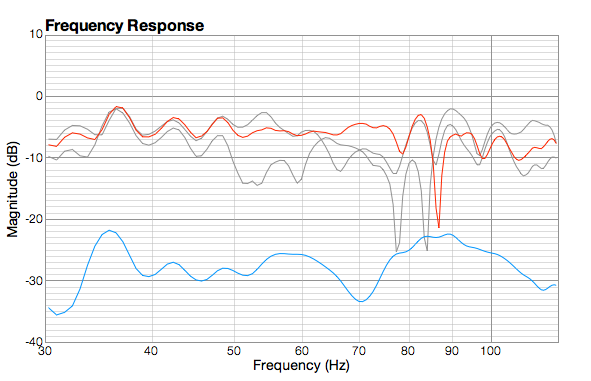

Dual dipole:
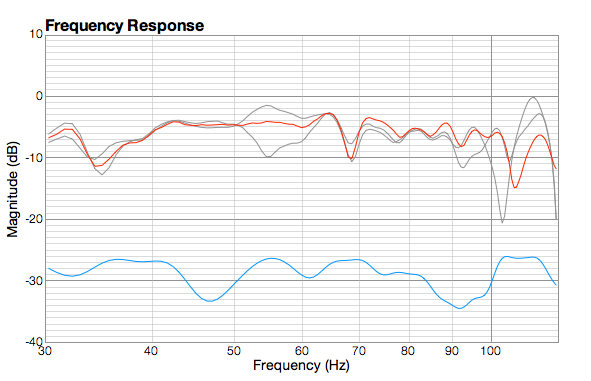

But the best results were achieved with two dipoles in the near field:
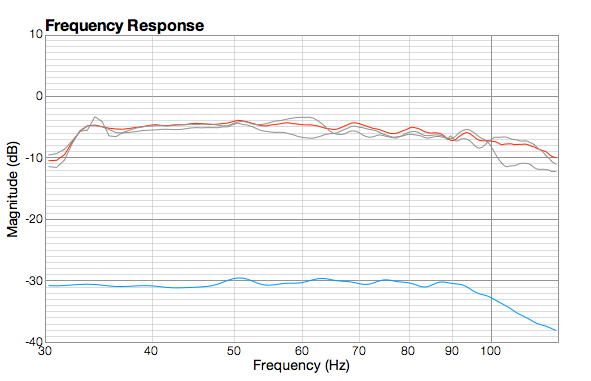

Near field configuration increases sub efficiency by a whopping 10dB.
Modal ringing is minimized.
The specific dipole near field sub required virtually no equalization.
Dual near field subs enlarge the usable listening area. Bass response is virtually the same within an area of 3 seats.
Comparison of different near field subwoofer configurations
I also did look at monopole/dipole in the far field. The dipoles were placed right next to the mains.
Dual monopole:


Dual dipole:


But the best results were achieved with two dipoles in the near field:


Near field configuration increases sub efficiency by a whopping 10dB.
Modal ringing is minimized.
The specific dipole near field sub required virtually no equalization.
Dual near field subs enlarge the usable listening area. Bass response is virtually the same within an area of 3 seats.
Last edited:
Near field configuration increases sub efficiency by a whopping 10dB.
Modal ringing is minimized.
Now you are just repeating what I said may post ago and showed at my web site years ago.
John, could you please post the promised impulse responses?
Hi Markus,
You know, I set the woofer up again, took all the data, made jpegs of the FR, Impulse, Burst waterfalls and sonograms. All sitting nicely in my photo editor. Then, before I had saved all the jpegs, the power failed and I lost it all. I haven't had the desire to do it a third time. I will tell you that you won't learn anything by looking at the impulses. They all looked similar in structure and had about the envelop for the decay rate.
It's raining today so if I get around to it I may give it another shot. But honestly, I'm not real motivated because I won't think it will really tell you anything.
And since bass without higher frequencies does not exist in nature it has to be phase coherent.
phase coherence from top to bottom.. that's not easy to get.. how do you manage?
Hi Markus,
You know, I set the woofer up again, took all the data, made jpegs of the FR, Impulse, Burst waterfalls and sonograms. All sitting nicely in my photo editor. Then, before I had saved all the jpegs, the power failed and I lost it all. I haven't had the desire to do it a third time. I will tell you that you won't learn anything by looking at the impulses. They all looked similar in structure and had about the envelop for the decay rate.
It's raining today so if I get around to it I may give it another shot. But honestly, I'm not real motivated because I won't think it will really tell you anything.
Sorry to hear that. You don't have the old ones anymore? I'm more interested in how your room behaves compared to mine.
Results for different near field configurations are in:
Markus - nicely done
Unfortunately its not a universal solution. I can't do it, just like I can't do the bass array cancellation technique. I have two rows of seats, and a door on the rear wall. With the multiple sub layout it can always be made to work and I suspect that the differences in sound quality will be minimal.
The fact is that DSP has changed the world of LF reproduction and I really think that all the techniques will be far closer to each other than any of them are to the "old way". The point is that if you are still using a single sub, or subs without EQ, then get with the program.
PS. in your writeup you say that you did 3 averages but all at the same mic position - 1. Whats the point in that?
Markus:
In post #530
What are microphone distances?
Windowing for spectrograms is too large and 30dB range is too small; can't get much from this view.
Here is 10" Peerless driver suspended 30" from carpeted floor, and >5ft. from walls and ceiling. Microphone is 30" above floor, and 30" from driver:
Frequency response:
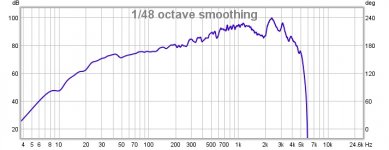
Impulse response:
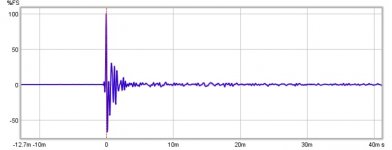
Spectrogram:
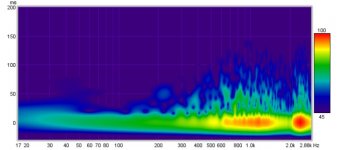
Spectrogram windowing is 60ms, Blackman-Harris 4
Inverse transfer function is generated from IR, band limited with FIR and minimum phase version generated of this inverse.
These inverses are applied to measurement sweep by convolution, and used to measure driver. Microphone and driver are undisturbed from initial measurement. Sound of sweeps during response recordings are smooth, audibly there is no reverberant/echo effects produced by inverse functions.
Results of linear phase correction filter:
Frequency response:
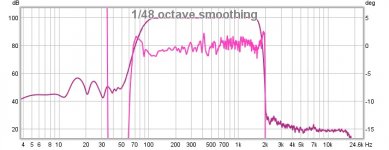
Impulse response:
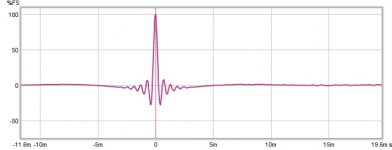
Spectrogram:
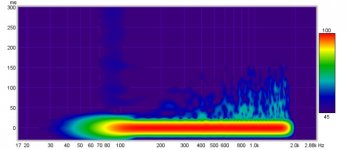
Results of converting linear phase filter to minimum phase filter:
Frequency response:
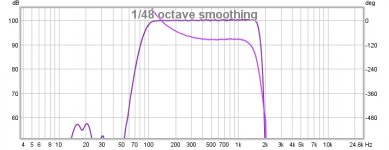
Impulse response:
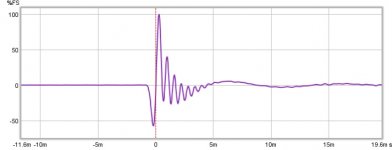
Spectrogram:
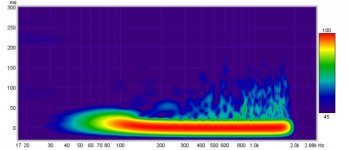
REW has nice group delay feature; overlays of GD for raw, linear phase EQ, and minimum phase EQ:

As usual, minimum phase filter is ruinous to group delay performance.
Regards,
Andrew
In post #530
What are microphone distances?
Windowing for spectrograms is too large and 30dB range is too small; can't get much from this view.
Here is 10" Peerless driver suspended 30" from carpeted floor, and >5ft. from walls and ceiling. Microphone is 30" above floor, and 30" from driver:
Frequency response:

Impulse response:

Spectrogram:

Spectrogram windowing is 60ms, Blackman-Harris 4
Inverse transfer function is generated from IR, band limited with FIR and minimum phase version generated of this inverse.
These inverses are applied to measurement sweep by convolution, and used to measure driver. Microphone and driver are undisturbed from initial measurement. Sound of sweeps during response recordings are smooth, audibly there is no reverberant/echo effects produced by inverse functions.
Results of linear phase correction filter:
Frequency response:

Impulse response:

Spectrogram:

Results of converting linear phase filter to minimum phase filter:
Frequency response:

Impulse response:

Spectrogram:

REW has nice group delay feature; overlays of GD for raw, linear phase EQ, and minimum phase EQ:

As usual, minimum phase filter is ruinous to group delay performance.
Regards,
Andrew
Markus - nicely done
Thanks.
in your writeup you say that you did 3 averages but all at the same mic position - 1. Whats the point in that?
I didn't want to introduce additional variables by Audyssey doing any "fuzzy clustering magic" but wanted it to behave like a single point equalization. 3 measurements are minimum for Audyssey.
Unfortunately its not a universal solution.
I believe it's THE solution for everybody that wants really good bass and doesn't have a dedicated listening room with proper acoustic treatments. It's also limited to a few seats within one row but is stereo/multichannel anything more than a one seat solution?
Near field subs can probably also made to work with the typical couch at the back wall layout. Would have to test it though.
Last edited:
The fact is that DSP has changed the world of LF reproduction and I really think that all the techniques will be far closer to each other than any of them are to the "old way".
I'm wondering how the source-to-sink principle could be exploited more by taking lots of measurements within a room and placing/processing sources accordingly.
- Status
- This old topic is closed. If you want to reopen this topic, contact a moderator using the "Report Post" button.
- Home
- General Interest
- Room Acoustics & Mods
- Measured monopole and dipole room responses